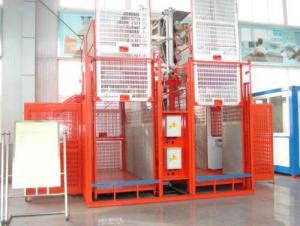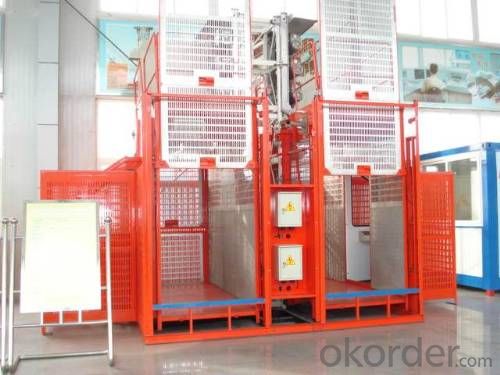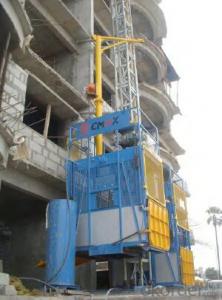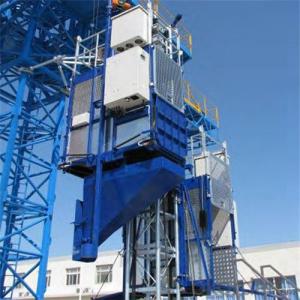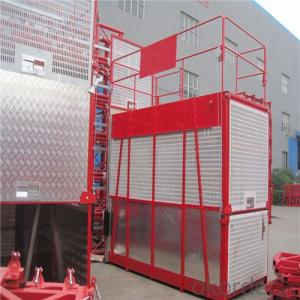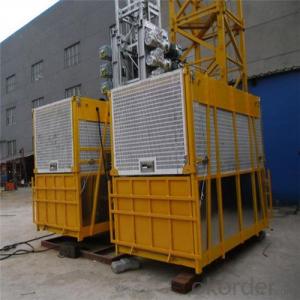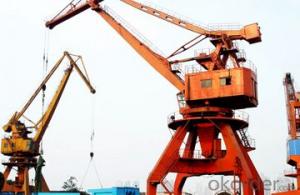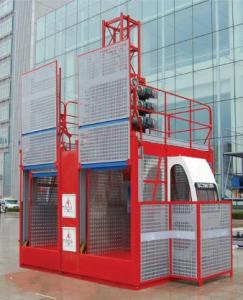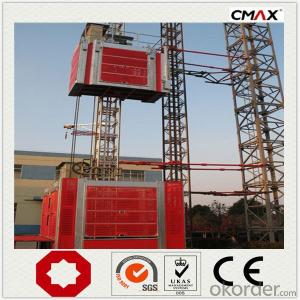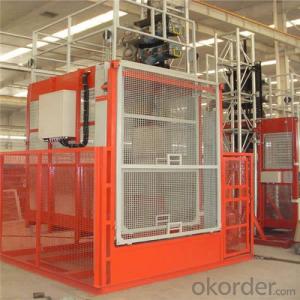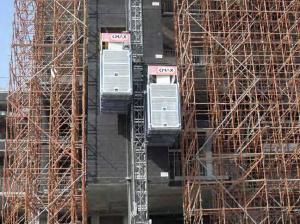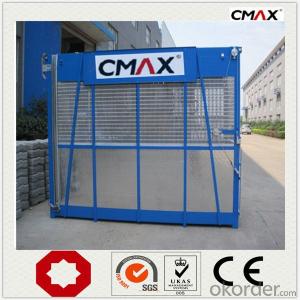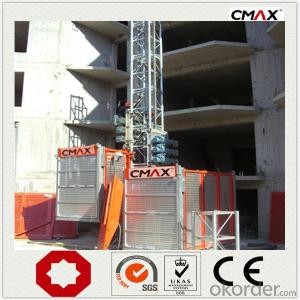Construction Hoist New SC160 Building Use
- Loading Port:
- China main port
- Payment Terms:
- TT or LC
- Min Order Qty:
- 1 unit
- Supply Capability:
- 30 unit/month
OKorder Service Pledge
OKorder Financial Service
You Might Also Like
Structure of Construction Hoist Description
1.Feature: Construction Hoist
2.Payload(kg):1600
3. Lifting Speed(m/min):33
4.Motor Power(kw): 2*11
5.Safety Device: SAJ30-1.2
6.Cage: Single
7.Counterweight: No
8.Certification: CE,ISO
9.Place of Origin: China(Mainland)
10.Model Number: Type:SC160
Packaging & Delivery of Construction Hoist
Packaging Detail: Nude package Delivery Detail: 25-30days
Main Parts of Construction Hoist
● The gearing adopts imported bearing, enameled cable, and oil seal.
● The electric parts adopt products from world renowned manufactures such as Schneider, Siemens, and LG.
● The racks and pinion adopts special material and heat-treatment technique, which prolong the life of these parts.
● The steel structure uses quality steel from famous domestic manufactures.
● The surface of the structure can apply paint-spray, parkerozing baking finish or hot galvanizing processing according
to users requirements,
● The cage can be produced and decorated by aluminum molded board, punched-plate or figured aluminm board.
Construction Hoist Specifiction
Single cage High speed
Model | Speed(m/min) | Deadweight(kg) | Motor(KW) | Counterweight | Specification(L×W×H)(m) |
SC100G | 96 | 1000 | 3×22 | No | 2.5×1.3×2.5 |
SC120G | 96 | 1200 | 3×22 | NO | 3.0×1.3×2.5 |
SCD200G | 96 | 2000 | 3×15 | Have | 3.2×1.5×2.5 |
SC200G | 96 | 2250 | 3×22 | No | 3.2×1.5×2.5 |
SC270GS | 96 | 2700 | 3×22 | No | 3.8×1.5×2.5 |
SCD270G | 96 | 2700 | 3×18.5 | Have | 3.8×1.5×2.5 |
SCD300G | 96 | 3000 | 3×22 | Have | 4.0×1.5×2.5 |
SCD320GS | 96 | 3200 | 3×22 | Have | 4.2×1.5×2.5 |
Single cage Medium speed
SC100GZ | 63 | 1000 | 3×15 | No | 2.5×1.3×2.5 |
SC120GZ | 63 | 1200 | 3×15 | No | 3.0×1.3×2.5 |
SCD200GZ | 63 | 2000 | 2×15 | Have | 3.0×1.3×2.5 |
SC200GZ | 63 | 2000 | 3×18.5 | No | 3.0×1.3×2.5 |
SC225GZ | 63 | 2250 | 2×18.5 | No | 3.2×1.5×2.5 |
SC225GZ | 63 | 2250 | 3×18.5 | Have | 3.6×1.5×2.5 |
SCD250GZ | 63 | 2500 | 2×18.5 | Have | 3.6×1.5×2.5 |
SC250GZ | 63 | 2500 | 3×18.5 | Have | 3.8×1.5×2.5 |
SCD270GZ | 63 | 2700 | 2×18.5 | Have | 3.8×1.5×2.5 |
SC270GZ | 63 | 2700 | 3×22 | NO | 4.0×1.5×2.5 |
SCD300GZ | 63 | 3000 | 3×15 | Have | 4.0×1.5×2.5 |
SCD320GZ | 63 | 3200 | 3×15 | Have | 4.2×1.5×2.5 |
Single cage standard speed
SC100TD | 36 | 1000 | 2×11 | NO | 2.5×1.3×2.5 |
SC120TD | 36 | 1200 | 2×11 | NO | 3.0×1.3×2.5 |
SC200TD | 36 | 2000 | 3×11 | NO | 3.0×1.3×2.5 |
SCD200TD | 36 | 2000 | 2×11 | Have | 3.2×1.5×2.5 |
SC270TD | 36 | 2700 | 3×15 | NO | 3.6×1.5×2.5 |
SCD270TD | 36 | 2700 | 2×11 | Have | 3.8×1.5×2.5 |
SC320TD | 36 | 3200 | 3×18.5 | NO | 4.0×1.5×2.5 |
SCD320TD | 36 | 3200 | 2×11 | Have | 4.2×1.5×2.5 |
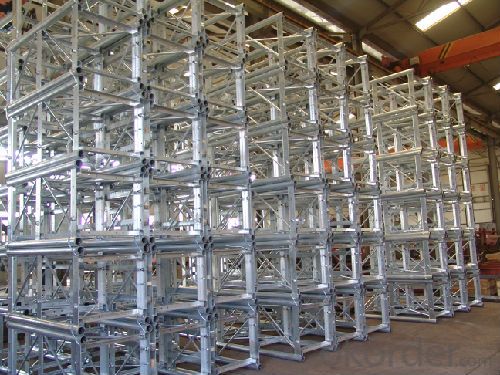
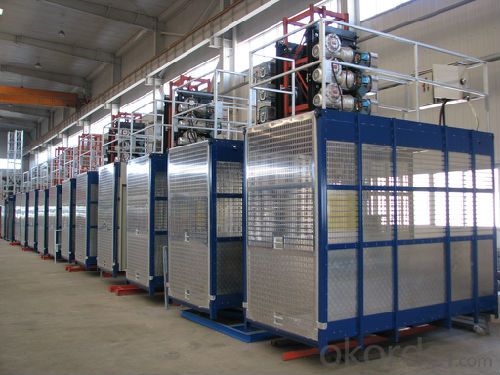
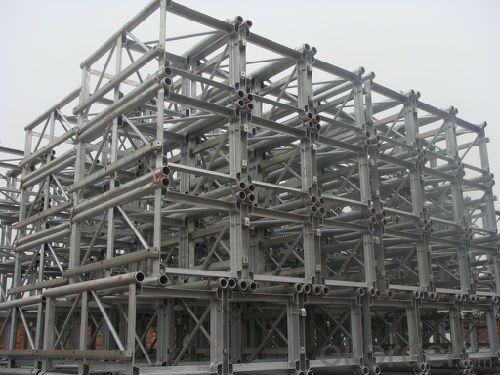
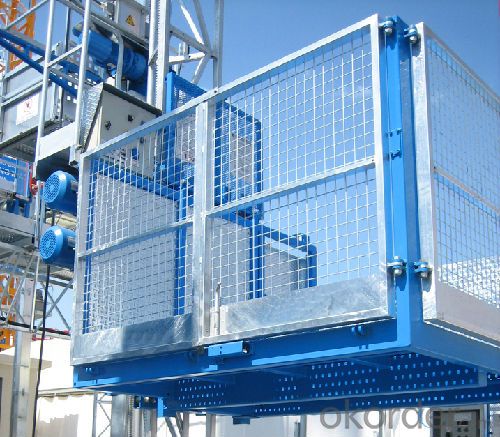
FAQ of Construction Hoist
Q: What is the building hoist main purpose?
A: Building hoist equipped with double or single cabin to transport the materials and labors up and down. It's the ideal
construction equipment for vertical transportation in the field of construction.
Q: What is the main structure of building hoist?
A: The P/M construction hoist mainly contains metal structure, driving system, electrical control system, cable guide &
protection system, electrical top crane and safety device.
Q: What is the meaning of the building hoist’s code?
A: Take SC200/200 for example: “SC” stands for rack and pinion hoist, “200/200” stands for double cage and capacity
is 2 tons per cage. “SC200” stands for single cage and capacity is 2 tons.
Q: What is the dimension of the cage?
A: Normally the cage dimension is 3X1.5X2.5M (L/W/H) for 2t type hoist. Details should be checked according to our
quotation sheet. Also, the size can be customized according to the factual site condition. There are two doors (entrance
& exit doors) for each cage, It can be produced as up & down sliding or ramping model for safety and convenience.
- Q: What fundamental specifications or conditions must be met to operate a building hoist with a hydraulic pump?
- <p>To use a hydraulic pump to power a building hoist, several basic requirements must be met: a reliable power source, a suitable hydraulic pump with the correct pressure and flow rate, a robust and leak-free hydraulic system, safety mechanisms such as pressure relief valves and emergency stop features, proper installation and maintenance procedures, and adherence to safety standards and regulations. Additionally, the pump should be compatible with the hoist's design and capable of providing the necessary force and speed for lifting operations. Regular inspections and maintenance are crucial to ensure the hoist operates safely and efficiently.</p>
- Q: This question asks for a comparison between lifting equipment used in indoor settings versus those used outdoors, focusing on their differences.
- <p>Indoor lifting equipment is designed for controlled environments, often smaller and more precise, with features like electric chain hoists or jib cranes. They are typically quieter, require less maintenance, and are suitable for tasks like assembly, manufacturing, and warehouse operations. Outdoor lifting equipment, such as gantry cranes or mobile cranes, is built to withstand harsh weather conditions, has higher load capacities, and is often used for construction, shipping, and heavy industry. These are more robust, may require more maintenance, and are designed for larger, heavier loads over uneven terrain.</p>
- Q: Is it possible to use a lifting device to assist in lifting a person who is too heavy to lift manually?
- <p>Yes, lifting devices such as hoists or mechanical lifts can be used to safely lift someone who is too heavy to lift manually. These devices are designed to support the weight and reduce the risk of injury to both the person being lifted and the caregiver. It's important to use the appropriate equipment for the individual's weight and to follow safety guidelines and manufacturer's instructions to ensure proper and secure lifting.</p>
- Q: How do construction suspension scaffolding be handled in the people's elevator?
- The shelf of the discharge platform is separated from the outer scaffolding and set up separately! Can't connect together
- Q: This question asks for the steps or process involved in installing a building hoist, which is a type of crane used in construction to lift materials.
- <p>Installing a building hoist involves several steps: 1) Site preparation, ensuring the ground is level and strong enough to support the hoist. 2) Assembling the hoist tower, starting from the base and working upwards. 3) Installing the motor and drive system. 4) Attaching the cable and counterweight. 5) Rigging the hoist with safety devices and load limiters. 6) Conducting a thorough inspection and testing the hoist for safety and functionality. 7) Obtaining any necessary permits and approvals. It's crucial to follow the manufacturer's instructions and local regulations, and often requires a professional team for safe and proper installation.</p>
- Q: This question asks if a building hoist is capable of lifting objects that vary in size and weight.
- <p>Yes, a building hoist can be used to lift objects of different sizes and weights, but it is crucial to ensure that the hoist's capacity is suitable for the load. Building hoists are designed to handle various materials and equipment during construction, and their lifting capacity can range from a few hundred pounds to several tons. It is essential to check the hoist's specifications and adhere to the maximum load limit to ensure safety and prevent damage to the hoist or the objects being lifted. Always follow the manufacturer's guidelines and safety standards when operating a building hoist.</p>
- Q: Is it possible to replace a building hoist with an electric winch for the purpose of lifting materials or individuals?
- <p>While theoretically possible, using an electric winch instead of a building hoist for lifting materials or people is not recommended due to safety concerns and differences in design. Electric winches are typically designed for pulling or towing loads and may not have the necessary safety features, load capacity, or stability required for lifting operations in a construction setting. Building hoists are specifically engineered to lift heavy materials and personnel safely in vertical shafts or on the facade of a building. They are equipped with safety devices and are regulated for construction use, making them the appropriate choice for such tasks.</p>
- Q: Is it possible to utilize a double-rope lifting mechanism within the context of a building hoist?
- <p>Yes, a double-rope lifting system can be used in a building hoist. This system offers advantages such as increased safety due to redundancy and the ability to lift heavier loads compared to a single-rope system. The double-rope setup allows for the hoist to handle the load with two separate ropes, reducing the risk of failure and providing a more stable lifting platform. It's common in applications where high load capacities and safety are paramount, such as in construction for lifting materials and equipment.</p>
- Q: This question asks about the time required to install a building hoist, a device used for lifting materials in construction.
- <p>The time it takes to install a building hoist can vary significantly based on factors such as the type and size of the hoist, the specific building requirements, and the experience of the installation team. On average, it can take anywhere from a few hours to a couple of days. For smaller hoists, installation might be completed within a day, while larger, more complex systems could take longer. It's important to note that safety checks and regulatory compliance verifications are also part of the process, which can add to the total installation time.</p>
- Q: This question asks if it is permissible to use a building hoist for the purpose of lifting people.
- <p>No, a building hoist should not be used for lifting people. Building hoists are designed for the transportation of materials and equipment during construction, not for carrying personnel. Using a building hoist to lift people is dangerous and against safety regulations. It poses significant risks, including falls and equipment malfunctions, which can lead to serious injuries or fatalities. Always use designated personnel lifts or other safe methods for moving people in construction settings.</p>
Send your message to us
Construction Hoist New SC160 Building Use
- Loading Port:
- China main port
- Payment Terms:
- TT or LC
- Min Order Qty:
- 1 unit
- Supply Capability:
- 30 unit/month
OKorder Service Pledge
OKorder Financial Service
Similar products
Hot products
Hot Searches
Related keywords
